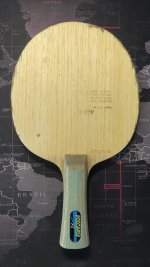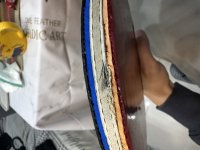This user has no status.
This user has no status.
Well-Known Member
Is sealing [lacquering] the blade important if the type of blade or wood being used is prone for damage or splinter?
I have DHS Long 5X and i asked the coach to apply lacquering to it, i think he knows what to do and how much layer or how thin, but for someone like me who doesn't worry much or care about the blades characteristics or performance changed i just always ask him to seal my new blades for the first time only once and then forget about it, i didn't try to do a very hard test comparison between sealed and non-sealed blade using the same rubbers, and the coach sounds never warned me not to apply but also he never mind if not applying, it is just he suggest to apply if i will change the rubbers, and i do change.
I am planning to buy one more maybe last blade later, and it sounds it comes with Ebony top layer, is this wood hard enough that sealing it is unnecessary? I saw someone was peeling off the rubber from his blade and it was like bad shape of top layer wood, it made me to believe that i just should seal blindly without thinking, i mean i will sacrifice the performance over the safety of top layer really, i have so many blades and rubbers, i don't think i will die to retain the blade performance that much not to seal it.
One of my replica blade i bought had kind of splinter on the handle although i asked the coach to seal the head, i can't imagine if he didn't seal the head and i change the rubber later after a while, how would that wood become after removing the rubber then, another reason for me to seal to be safe, and i play ok and fine enjoying with the blades so far, i tried some of others players blades that i assume they never seal and i didn't feel their blades are heavenly better and higher performance even over my cheap replica blade, but reading some topics here about sealing i fee like many are just scared to lose the blade pros non-sealed as it came.
I have DHS Long 5X and i asked the coach to apply lacquering to it, i think he knows what to do and how much layer or how thin, but for someone like me who doesn't worry much or care about the blades characteristics or performance changed i just always ask him to seal my new blades for the first time only once and then forget about it, i didn't try to do a very hard test comparison between sealed and non-sealed blade using the same rubbers, and the coach sounds never warned me not to apply but also he never mind if not applying, it is just he suggest to apply if i will change the rubbers, and i do change.
I am planning to buy one more maybe last blade later, and it sounds it comes with Ebony top layer, is this wood hard enough that sealing it is unnecessary? I saw someone was peeling off the rubber from his blade and it was like bad shape of top layer wood, it made me to believe that i just should seal blindly without thinking, i mean i will sacrifice the performance over the safety of top layer really, i have so many blades and rubbers, i don't think i will die to retain the blade performance that much not to seal it.
One of my replica blade i bought had kind of splinter on the handle although i asked the coach to seal the head, i can't imagine if he didn't seal the head and i change the rubber later after a while, how would that wood become after removing the rubber then, another reason for me to seal to be safe, and i play ok and fine enjoying with the blades so far, i tried some of others players blades that i assume they never seal and i didn't feel their blades are heavenly better and higher performance even over my cheap replica blade, but reading some topics here about sealing i fee like many are just scared to lose the blade pros non-sealed as it came.











